I rarely see Gray Partridges in Utah. Nearly all of my opportunities with them have been on the family farm in Montana so yesterday morning it was a real treat to find a family group of them at Golden Spike National Historic Site here in Utah.
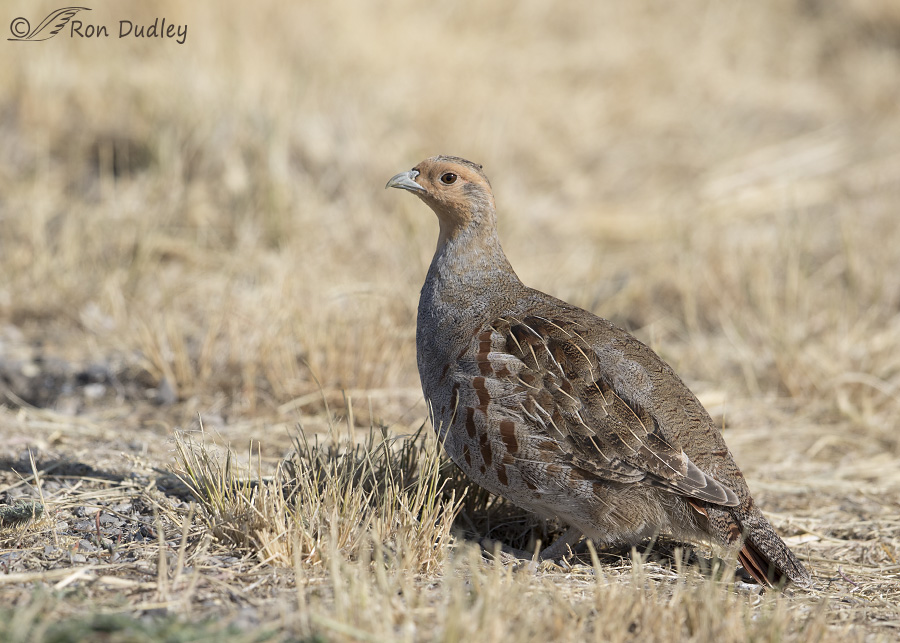
1/2000, f/6.3, ISO 200, Canon 7D Mark II, Canon EF 500mm f/4L IS II USM + 1.4 tc, not baited, set up or called in
These birds, native to Europe and Asia, were introduced into North America in the early 1900’s as a game bird. Locals usually refer to them as Hungarian Partridges or “Huns” for short and that’s what we always called them in Montana.
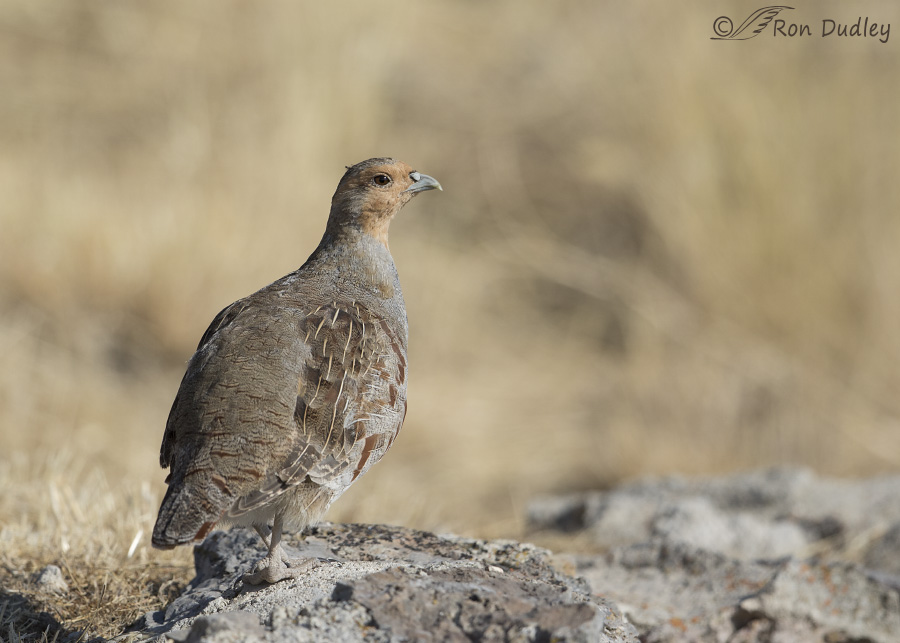
1/2500, f/6.3, ISO 200, Canon 7D Mark II, Canon EF 500mm f/4L IS II USM, not baited, set up or called in
I never did count the birds in the family group I saw yesterday but there must have been 15 – 20 of them. Most were juveniles but at least two were adults, presumably the parents.
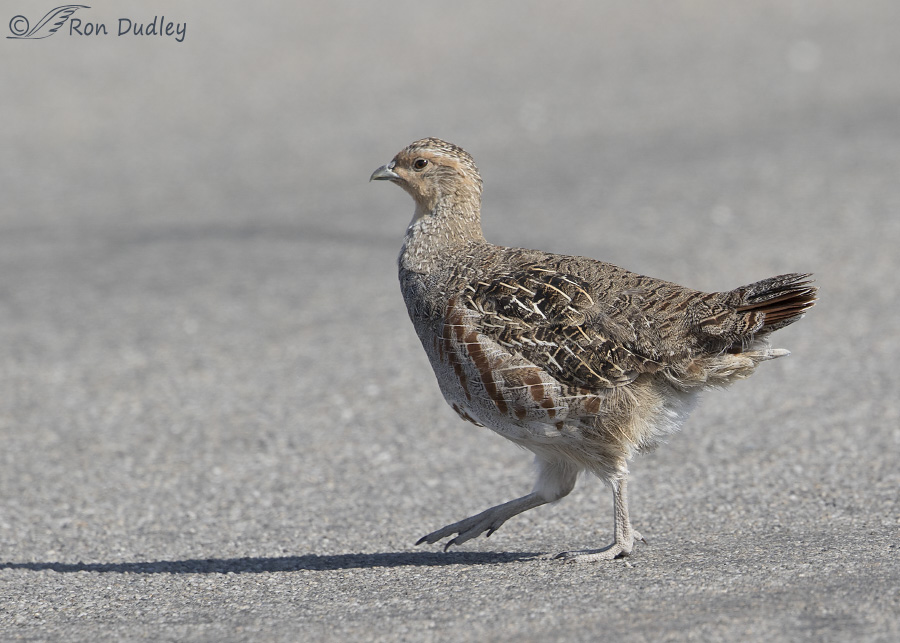
1/1000, f/7.1, ISO 200, Canon 7D Mark II, Canon EF 500mm f/4L IS II USM + 1.4 tc, not baited, set up or called in
When this juvenile crossed the road in front of me I thought it looked a bit like a young chicken so I couldn’t help thinking of the old (and overused) riddle joke – “Why did the chicken cross the road?” and smiling.
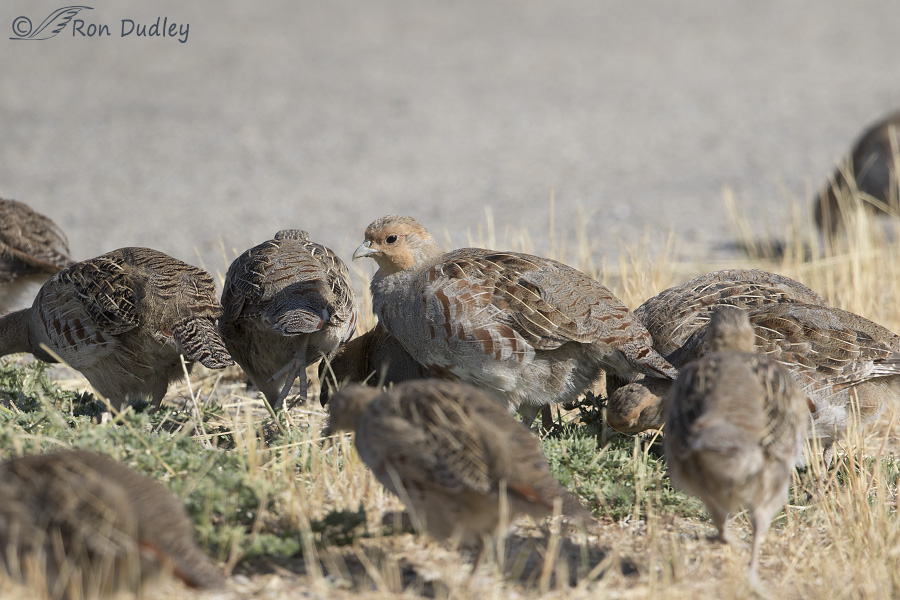
1/1000, f/9, ISO 200, Canon 7D Mark II, Canon EF 500mm f/4L IS II USM + 1.4 tc, not baited, set up or called in
This is a terrible photo, mostly butts and out of focus birds (I should have switched to my smaller zoom lens), but it gives the viewer a feeling for the family group.
Gray Partridge hens produce some of the largest clutches of any bird species. Clutch size can range up to 22 eggs, and averages 16 to 18. And it’s a good thing because they have an unusually high mortality rate and short life span.
It’s hard to imagine that many eggs under a single hen but they have a unique way of managing it. The tightly-packed eggs are arranged in the nest with the points down and towards the middle so the blunt end contacts the female – an efficient way to utilize limited space.
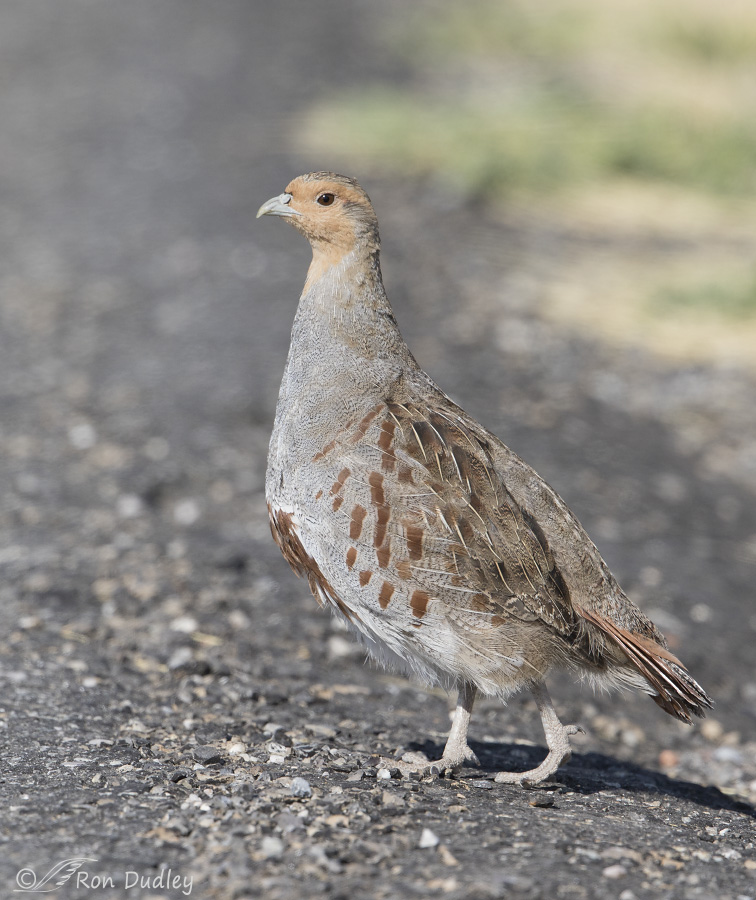
1/1000, f/7.1, ISO 200, Canon 7D Mark II, Canon EF 500mm f/4L IS II USM + 1.4 tc, not baited, set up or called in
Gray Partridges exhibit little sexual dimorphism so I hesitate to ID this bird as male or female but it’s an adult. Here it paused on the edge of the road to look for danger before the rest of the group crossed the road.
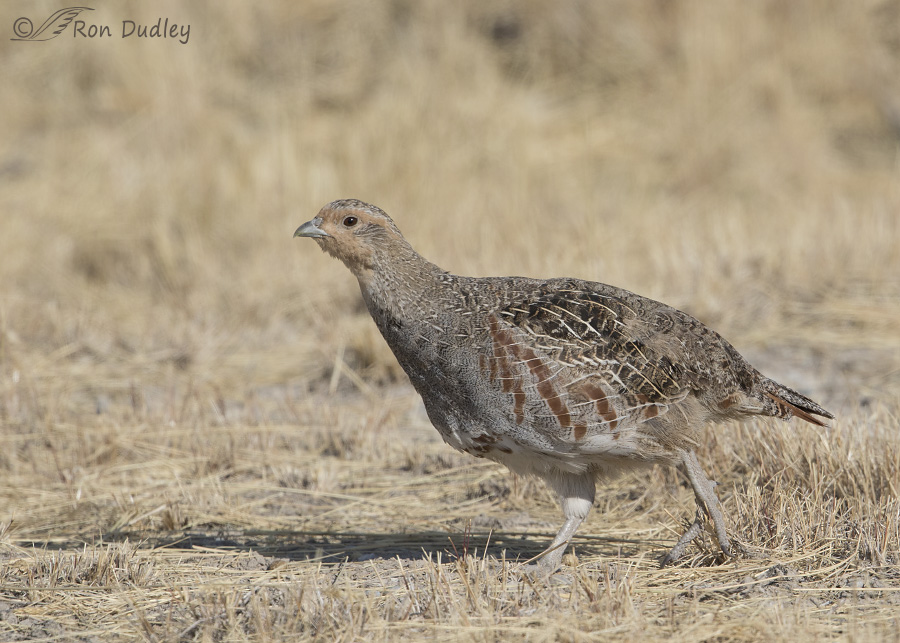
1/1250, f/7.1, ISO 200, Canon 7D Mark II, Canon EF 500mm f/4L IS II USM + 1.4 tc, not baited, set up or called in
These birds can really scoot when they want to so it’s a challenge to keep one in focus when it’s close and running.
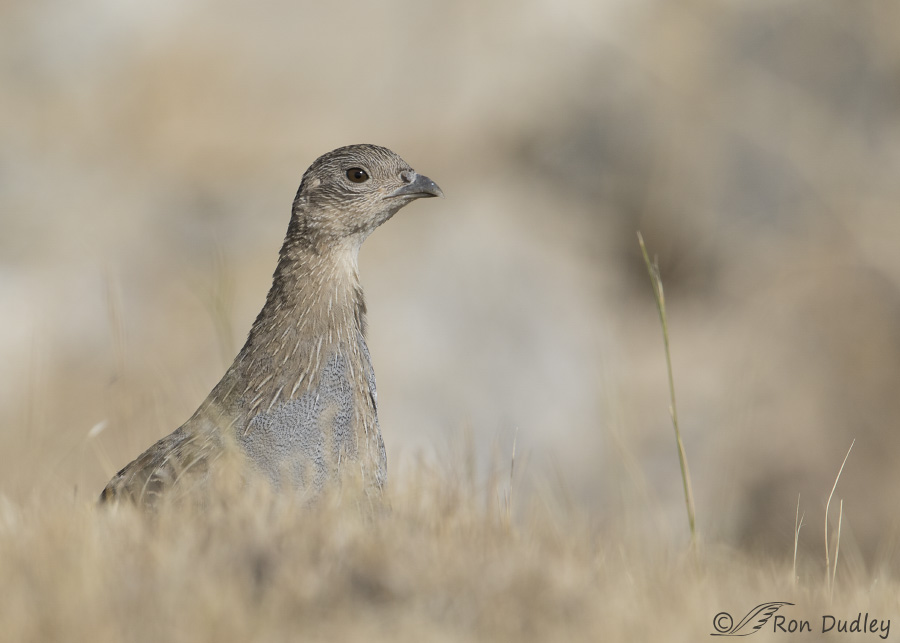
1/2000, f/7.1, ISO 200, Canon 7D Mark II, Canon EF 500mm f/4L IS II USM + 1.4 tc, not baited, set up or called in
This is how I usually used to see the species in Montana with only their heads sticking up out of the grass as they tried to decide whether to hide or flee. As a kid I used to call them “heart attack birds” because if you unexpectedly flush a flock of them in front of you their loudly whirring wings and shrieking alarm calls will instantly send gallons of adrenalin rushing through your system and leave your heart pounding hard for some time after!
This family group will remain together until late winter or early spring when birds start to pair up for a new breeding season.
Ron


Late to the party, Ron, but I really love everything about this series, even the group photo where the center bird is giving you a nice profile pose. Thanks for posting!
Subtle charmers. And a better reason for a heart attack than many.
Thank you, EC.
I’ve never seen a partridge in the wild. Thanks for sharing the images and insights! I love learning about birds that are new to me, and you have a lot of birds out there that we don’t in the greater D.C. area (or at least that I haven’t had the pleasure of seeing yet!). I really like the last image, from an artistic perspective. Nice background, really stands out, curious look to the bird. But I love the others for showing little bits of behavior and more detail of the coloration of the rest of the body. Very attractive species, even if it sometimes looks like a chicken crossing the road (had me chuckling).
Todd, images like that last one can be a matter of taste so I appreciate knowing that you like it. Thanks.
I enjoy all your photos, even those you think aren’t good in terms of compositions. Seeing out-of-focus birds and butts adds to the overall sense of what you were seeing. Thanks for sharing.
Thanks for appreciating that group shot, Linda. It has a lot of imperfections but it does give you a sense for the flock.
Superb photographs of the Partridge Family! The closest thing we have to them here in Florida is the Northern Quail with their wonderfully clear “Bob White” call. They, too, can get your heart started when a dozen flush from under your feet!
Thank you for sharing more interesting information and images.
I’ve never even seen Northern Quail, much less photographed them, Wally. So many birds and so little time…
Thanks, Ron! The info about these birds makes me think about the Gambel’s Quail so prevalent in the Phoenix area desert. I have been recording their behaviors in my backyards (3 yards over 19 years) year round. The first large Gambel’s Quail family I noted was 2 adults, male and female and 19 chicks! The parents were clearly experienced in raising chicks because they were able to round them up without stragglers! In my neighborhood, we all stop for quail in the road because we don’t know how many chicks will be following the adults. I have seen quail eggs on the ground in cactus and pots on patios but I have yet to see a female incubating them. My best guess about the incubation is that it is the desert heat which does the job.
Pat, As I suspect you know our California Quail is very similar to your Gambel’s Quail, but lacking the dark belly patch.
It’s easy to see why these meaty-looking birds are popular with hunters…For me, the Ring-necked pheasants were the “heart attack” birds! Our Irish setter, my constant companion, Michael (after whom my son is named), helped some, flushing many of them ahead of us, but I almost stepped on most of them….causing them to exploded under my nose!!! Amazing that those birds can brood so many at once…
Yes, they’re quite popular with hunters in some areas, Patty – part of the reason hunters are disturbed by their recent significant decline in numbers. They’re still being introduced from Europe and Asia in some areas of the country to try to make up for it.
Beautiful shots and some interesting information. Twenty two….I’m just tired thinking about all aspects of that!!
Love the peachy colored heads. Thanks for sharing these.
I had the same thought about caring for that many young’uns, Carol.
Beautiful birds. I think my favorite shot is the juvenile crossing the road. I will probably never see these birds, so I appreciate your posting them.
I’m glad you enjoyed them, Susan. Thanks.
Once again Ron, great stuff. If I had to choose a favorite, I would select the last one. Great habitat shot and love the background.
Appreciate your thoughts yesterday re locating Bald Eagles. My wife was on the internet last night and came up with Fish Springs as an option for Raptors in the winter. Do you have any thoughts about how this refuge is set up, accessibility etc. For instance, access in the Centennial Valley is limited, while access to Camas via auto is pretty good. How does Fish Springs compare? Thanks in advance. Frank
Thanks, Frank.
I’ve never been to Fish Springs in mid-winter. In the early spring it has some raptors but it isn’t loaded with them in my experience. There’s been an adult Bald Eagle that habitually roosts in the cottonwood tree in the picnic area and it’s been there for years, though one friend didn’t see it recently. There’s also a fair number of harriers at FS.
FS is one of the most remote NWR’s in the country – even more remote than Red Rock Lakes. It’s quite a drive to get there and the nearest motels are in Wendover. Camping isn’t allowed on the refuge but you can camp along the road right at the western boundary. There’s usually a loop road open you can take around some of the impoundments.
I saw these too and only saw their heads up out of the grass like your photo. I did not know what they were. I thought they were immature ring neck pheasants, but was surprised by the number of them. Pheasants don’t usually have large groups. Great photos and information, I will watch for them again. I think I might be taking another trip to the Spiral Jetty Saturday.Ever since I posted a photo of me in waist high sea foam all my visiting friends and family have wanted to go to the Jetty. I have made 6 trips this year! Good thing I love it out there.
April, if you get the chance you might want to talk to Jeremy Shaw, manager of Antelope Island State Park, about the jetty. His father-in-law actually built the jetty (under the direction of Robert Smithson of course) and Jeremy has some fascinating stories to tell about the construction.
Jeremy is very approachable, a nice guy, and I think he’d appreciate your interest in the place.
Here we go again with the string of ridiculously redundant string of OH WOW superlatives! Odd how you manage to make me do that on a daily basis, isn’t it? I just love your work, but you know that by now!
I just love your work, but you know that by now!
I know that heart-attack feeling well, not only with huns, but also quail and pheasants! It’s cool to have a pointing dog out there to warn you where they are so that doesn’t happen because there’s at LEAST a gallon of adrenalin pumped into your system when they flush en masse. Overall, dogs are very useful in keeping one healthy and happy.
But aren’t huns just beautiful?! Even with their method of incubation, it seems impossible that they can bring that number of eggs to hatch, and yet, they do. Birds/critters do a lot of impossible things, don’t they?!
Guess I’ll have to get a dog, Laura… I’ve had dogs for most of my life but they often don’t mix well with bird photography so it’s been a while. I miss having a dog…
Dogs are wonderful overall, but I don’t think they’d be real helpful in what you’re doing. That said, a good bird dog is an outstanding asset when you’re trying to prove your worth to a hawk/falcon OR just hiking fields and want to avoid those heart attack moments. A hawk/falcon soon learns what a point means and they like it. But they have an entirely different objective when they’re in the field
Great shots of birds I’ve never seen Ron! Thanks for sharing!
Charlotte
Thank you, Charlotte.
Once again you found something special. Do you just park on the road and wait for something to pass by! I am usually driving down the road, but slower and when I see something move, try to get my camera ready, but too late. lol
“Do you just park on the road and wait for something to pass by!”
Sometimes I do, Trudy, but more often I’m driving to find them and then TRY to approach them closely, which is what I did with these partridges.
These are lovely! I especially like the first photo. What exquisite coloration. And yes, I know that ‘heart attack’ sensation when one accidentally flushes a flock of birds!
Thank you, Alison.
Where do you get all of your information. I can always count on you to teach me. We used to have Huns in Ontario but they have lost their habitat to large housing developments. Humans keep doing that! Nice images.
Ron (Mr. Dudley) was a high school biology teacher to many of us who now follow his blog. I believe HE is the source of all this great information he shares with us ;)…
I have used the lessons he taught us to enrich my experiences in the field with my kids countless times! They know a red tail hawk is a “ferruginous” hawk and birds mate with a “cloacal kiss” because Mr. Dudley taught me those things. Over 35 years ago, too! Ron was and is a GREAT teacher…
What a nice thing to say, Joe (I still think of you as Joey…). I have fond memories of both you and Karen (and Don and Lorna Hague of course). I don’t know about Red-tailed Hawks being Ferruginous Hawks but you sure remembered the cloacal kiss right. Thanks for the kind words. And the memories.
On South High!
Go Cubs!
I should have said you taught me the “difference between” a ferruginous and red tailed hawk…
I hope the rest of the test is true/false or I’m bound to fail
Joey
You get extra credit for correcting your error, Joe!
Judy, I use a variety of sources to confirm my information but Birds of North America Online (a pay subscription site) is probably the main one.
Great shots Ron, thanks for sharing.
They aren’t the only heart-attack birds, Ruffed Grouse do the same thing. The difference is that Gray Partridges do it together whereas Ruffed Grouse do it singly. I have had my heart in my throat several times!
I’ve had the same thing happen with Ring-necked Pheasants and Sage Grouse, Dick. But for me the Hun is most effective at scaring the poop out of me because there’s usually so many birds that flush.